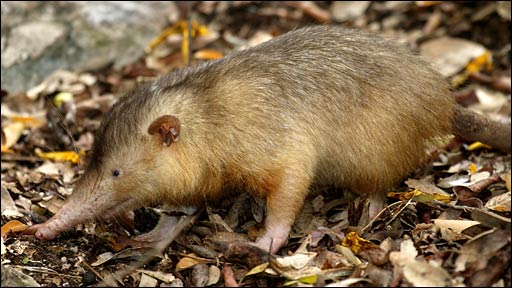Rare footage of one of the world's most strange and elusive mammals has been captured by scientists.
Large, and with a long, thin snout, the Hispaniolan solenodon resembles an overgrown shrew; it can inject passing prey with a venom-loaded bite.
Little is known about the creature, which is found in the Caribbean, but it is under threat from deforestation, hunting and introduced species.Researchers say conservation efforts are now needed.
The mammal was filmed in the summer of 2008 during a month-long expedition to the Dominican Republic - one of only two countries where this nocturnal, insect-eating animal (Solenodon paradoxus) can be found (the other is Haiti). The researchers from the Durrell Wildlife Conservation Trust and the Ornithological Society of Hispaniola were able to take measurements and DNA from the creature before it was released.... The Hispaniolan solenodon is one of the creatures highlighted by the Zoological Society of London's (ZSL) Edge of Existence programme, which focuses its efforts on conservation plans for animals that are both endangered and evolutionarily distinctive. ...
Dr Sam Turvey, a ZSL researcher involved with the programme, told BBC News: "It is an amazing creature - it is one of the most evolutionary distinct mammals in the world.
"Along with the other species of solenodon, which is found in Cuba (Solenodon cubanus), it is the only living mammal that can actually inject venom into their prey through specialised teeth.
"The fossil record shows that some other now-extinct mammal groups also had so-called dental venom delivery systems. So this might have been a more general ancient mammalian characteristic that has been lost in most modern mammals, and is only retained in a couple of very ancient lineages." ...
The researcher said that the team was surprised to find them; previously it had been feared that the creatures had become extinct in this country because of extensive deforestation, recently introduced mongoose and dogs, and hunting by humans for food.
He said: "They are still incredibly vulnerable and fragile. So it is really important to get back out there to work how how these animals are surviving."
Cute little things, aren't they?


No comments:
Post a Comment